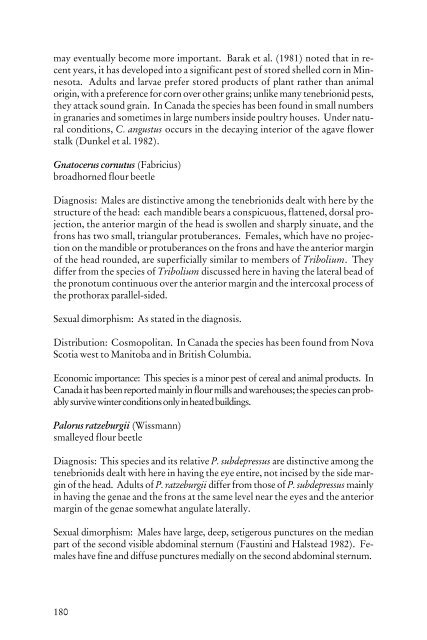Beetles Identification Guide
Beetles Identification Guide
Beetles Identification Guide
Create successful ePaper yourself
Turn your PDF publications into a flip-book with our unique Google optimized e-Paper software.
may eventually become more important. Barak et al. (1981) noted that in recent<br />
years, it has developed into a significant pest of stored shelled corn in Minnesota.<br />
Adults and larvae prefer stored products of plant rather than animal<br />
origin, with a preference for corn over other grains; unlike many tenebrionid pests,<br />
they attack sound grain. In Canada the species has been found in small numbers<br />
in granaries and sometimes in large numbers inside poultry houses. Under natural<br />
conditions, C. angustus occurs in the decaying interior of the agave flower<br />
stalk (Dunkel et al. 1982).<br />
Gnatocerus cornutus (Fabricius)<br />
broadhorned flour beetle<br />
Diagnosis: Males are distinctive among the tenebrionids dealt with here by the<br />
structure of the head: each mandible bears a conspicuous, flattened, dorsal projection,<br />
the anterior margin of the head is swollen and sharply sinuate, and the<br />
frons has two small, triangular protuberances. Females, which have no projection<br />
on the mandible or protuberances on the frons and have the anterior margin<br />
of the head rounded, are superficially similar to members of Tribolium. They<br />
differ from the species of Tribolium discussed here in having the lateral bead of<br />
the pronotum continuous over the anterior margin and the intercoxal process of<br />
the prothorax parallel-sided.<br />
Sexual dimorphism: As stated in the diagnosis.<br />
Distribution: Cosmopolitan. In Canada the species has been found from Nova<br />
Scotia west to Manitoba and in British Columbia.<br />
Economic importance: This species is a minor pest of cereal and animal products. In<br />
Canada it has been reported mainly in flour mills and warehouses; the species can probably<br />
survive winter conditions only in heated buildings.<br />
Palorus ratzeburgii (Wissmann)<br />
smalleyed flour beetle<br />
Diagnosis: This species and its relative P. subdepressus are distinctive among the<br />
tenebrionids dealt with here in having the eye entire, not incised by the side margin<br />
of the head. Adults of P. ratzeburgii differ from those of P. subdepressus mainly<br />
in having the genae and the frons at the same level near the eyes and the anterior<br />
margin of the genae somewhat angulate laterally.<br />
Sexual dimorphism: Males have large, deep, setigerous punctures on the median<br />
part of the second visible abdominal sternum (Faustini and Halstead 1982). Females<br />
have fine and diffuse punctures medially on the second abdominal sternum.<br />
180
















